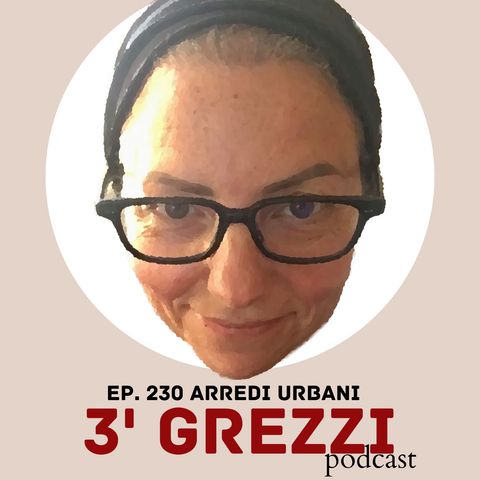3' grezzi Ep. 231 Arredi urbani (Eser. #2)

Download and listen anywhere
Download your favorite episodes and enjoy them, wherever you are! Sign up or log in now to access offline listening.
Description
Un semaforo, la targhetta col numero civico a fianco a un portone, una cabina telefonica, una panchina. Sono gli elementi che costituiscono l'arredo urbano, elementi che contribuiscono a creare il...
show moreTESTO TRASCRITTO (English translation below)
Frammenti urbani, i piccoli oggetti che raccontano le città. È questo il titolo del libro di Vittorio Magnano Lampugnani ed è una guida al vagabondaggio urbano. È un libro che parla di una delle mie passioni, cioè la città in tutti i suoi aspetti più frammentari, le piccole pillole che io, in un modo o nell'altro, continuo a elaborare anche nelle mie produzioni audio di podcast. In questo libro di Vittorio Magnano Lampugnani, libro che ancora io non ho, ho solo letto la recensione però appena possibile me lo compro, vado in libreria e lo prendo, offre in questo libro una rassegna di frammenti di quelli che sono gli arredi delle città, e lui li divide in tre categorie: le micro architetture, quindi i chioschi, i bagni pubblici, le fermate dei mezzi pubblici, gli ingressi delle metropolitane, ma anche le cabine telefoniche; poi cataloga quelli che sono veri e propri oggetti, quindi pensate alle fontane, ai monumenti, alle panchine dove ci si siede, ai lampioni della luce, ma anche ai semafori per arrivare fino ai numeri civici che sono apposti a fianco all'ingresso dei portoni; e poi la terza categoria è quella degli arredi, degli elementi di arredo, cioè le pavimentazioni, i tombini (che a volte se mai avete fatto caso i tombini a volte hanno dei veri e propri disegni, dei veri e propri arabeschi, delle cose molto intricate, dei fiori soprattutto quelli antichi) per arrivare poi fino alle pavimentazioni e alle recinzioni. Quindi è un libro che parla della città, delle cose che la compongono con un occhio di riguardo per il particolare e per il dettaglio. Questo è anche il modo che io prediligo di navigare la città. A volte faccio delle strade, dei percorsi che faccio sempre, ad esempio quello che da casa mia porta il mercato, che faccio molto spesso, però mi ripropongo di fissare il mio sguardo verso i piani alti dei palazzi, e facendo così scopro delle cose che, in quella strada che percorro moltissime volte alla settimana, scopro sempre dei nuovi particolari che prima non avevo mai notato, magari un balcone che ha dei fiori particolari, o un colore diverso, una costruzione, ecco è un esercizio urbano che vi suggerisco di fare: la prossima volta che fate un percorso che fate spesso, concentrato il vostro sguardo a un'altezza che solitamente non è quella che è la vostra altezza normale per camminare. E vi assicuro scoprirete delle cose mai viste prima.
ENGLISH TRANSLATION
Urban fragments, the small objects that narrate the city. This is the title of Vittorio Magnano Lampugnani's book and it is a guide to urban wandering. It is a book that talks about one of my passions, that is the city in all its most fragmentary aspects, the little pills that I, in one way or another, continue to explore also in my audio podcast productions. In this book by Vittorio Magnano Lampugnani, a book that I still do not have, I have only read the review but I am going to buy it as soon as possible, I'll go to the bookstore to buy it, in this book he offers a review of fragments of what are the furnishings of the cities, and he divides them into three categories: micro-architectures, i.e. kiosks, public toilets, public transport stops, subway entrances, but also telephone booths; then he catalogs those that are real objects, think of fountains, monuments, the benches where you sit, street lamps, but also traffic lights to end up with the house numbers that are affixed on the entrance to the side of the doors; and then the third category is that of furnishings, elements of furniture, i.e. floors, manholes (if you have ever noticed, the manholes sometimes have real designs, real arabesques, very intricacies, especially the ancient ones) to then include pavements and fences. So it is a book that talks about the city, about the elements that compose it with an eye for detail and particulars. This is also my favorite way of navigating the city. Sometimes I take the streets, the paths that I always take, for example the one that takes me from my home to the market, which I walk very often, but then I fix my gaze towards the upper floors of the buildings, and in doing so I discover new things, in that street that I walk many times a week, I always discover new details that I had never noticed before, perhaps a balcony that has particular flowers, or a different color, a building. Here is an urban exercise that I suggest you do: the next time you take a route that you do often, focus your gaze at a height that is different from where you normally have your gaze while walking. I assure you, you will discover things never seen before.
Information
| Author | M. Cristina Marras |
| Organization | M. Cristina Marras |
| Website | - |
| Tags |
Copyright 2024 - Spreaker Inc. an iHeartMedia Company
